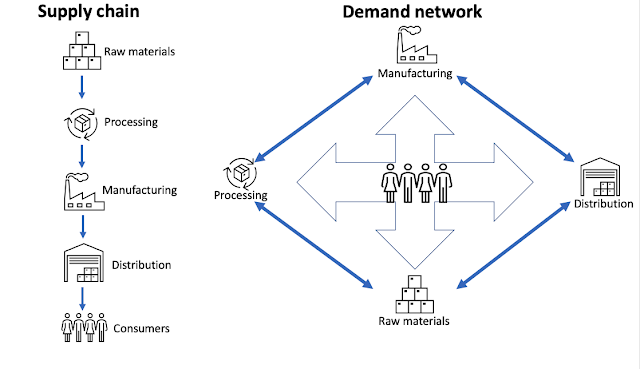Demand Management in the Customer-Centric Supply Chain
Supply chains evolving into demand networks.
Supply chain management overlooks the end-to-end production flow of goods or services — from the raw materials to the final product delivery to the end consumer.
With the rise of information technologies, the role of consumers has become dominant in supply chains. They can now communicate directly with retailers and manufacturers and purchase customized goods and services from the source.
The historical role of supply chains - the timely and cost-effective delivery of supplies to the point of consumption - developed into the ability to understand, satisfy, and manage consumer demand.
Supply chains focus on efficiently matching supply with demand.
Unfortunately, they don't help businesses determine what the customer perceives as valuable and how that value can be translated into propositions.
Therefore, supply chains evolved into customer-centric demand networks.
The satisfaction of demand happens by matching supply and demand. There are two solutions to that.
The traditional solution is forward chaining. The analysis starts from the existing conditions and applies the production rules until it produces a state in demand.
This is how supply chains emerged to extend material flows to end customers and optimize them by responding to demand fluctuations.
Another solution is backward chaining.
The analysis starts from the query itself and searches for one or more production rules that would produce this query. It keeps moving backward to find prior rules until it finds a rule whose initial condition is already satisfied.
Backward chaining resulted in demand networks moving from the initial condition of satisfying demand to the origin of adequate supply.
Demand chain attributes
Disintermediation
One of the most important aspects of demand chains is disintermediation -
"cutting out the middleman."
The more links there are in a chain between supply and demand, the more time, money, and effort required to reach the end of the chain, and less value will remain.
Thanks to the Internet, demand chain productivity can be improved by reducing the number of middlemen and allowing original goods manufacturers to connect directly with the consumers.
Reverse information flows in supply chains.
The traditional flow of information in supply chains originates from raw material suppliers and goes to retail outlets and customers.
Thereby, the firm achieves transparency and manageability of links involved in the product delivery to the point of consumption.
In demand networks, the information flow originates from consumers and returns to manufacturers to better understand market dynamics, customer behaviors and preferences, and sales channel efficiency.
Real-time information
Businesses must be able to reduce uncertainties about shifting demand by relying on real-time information right from the "battlefield."
Customer identity
Sharing real-time information with partners and suppliers will create a realistic image of individual consumers.
Thereby, businesses become capable of addressing the unique needs of their customers, who increasingly favor customization and respect for their identity.
Channel competition
In the customer-centric marketplace, there is a trend that competition increasingly moves from the company versus the company to the channel versus the channel.
The channel performance becomes the center of attention instead of developing individual links in the channel.
Demand management in the customer-centric supply chain
Based on the real-time data from its demand network, a company may start using some highly effective demand management tools.
Electric grid operators propose the demand response program to their customers, an opportunity to reduce or shift electricity usage during peak periods in response to time-based rates or other financial incentives.
Public service providers use social tools to shape consumption trends by changing citizens' behaviors.
Overall, the intention of demand response is to manage customers' consumption behavior, which is the highest level of demand management sophistication.
While customer-centricity is given for marketing, consumers must be the starting point for developing differentiated and customized chains.
P.S. If you appreciate hundreds of hours invested in researching and writing this blog, you can buy me a coffee or subscribe for the membership by following this link. Thank you!
More information on this and other exciting topics can be found in "The Technology Procurement Handbook." It represents 23 years of experience, billions of dollars worth of successful sourcing projects, and 1000s of hours spent on research, analysis, and content creation for the most demanding professional readers.






Comments
Post a Comment